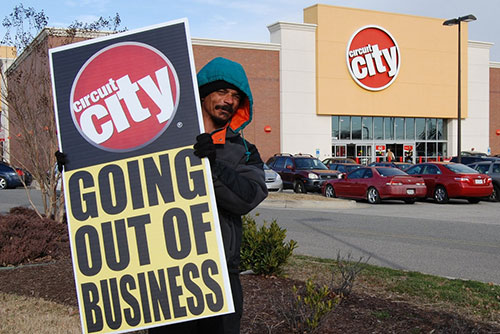Today in Tedium: If you’re looking for a great deal on athletic goods and live in a big city on the East Coast, your best option may perhaps be City Sports. The athletic chain, which has been around for more than 30 years, announced earlier this month that it was closing its doors, ensuring this Black Friday is a little bit more of a Bleak Friday for fans of italicized Helvetica type. But what sort of gets me about the phenomenon of store closings is how monolithic they are. Branding, often first and foremost in retail, gets thrown out the window almost immediately, replaced with these giant signs that announce the depths of the discounts that the failed store is offering. It’s depressing, which means it’s a perfect topic for today’s Tedium. — Ernie @ Tedium
Editor’s note: Tedium will take Thanksgiving off. You should, too.
1,784
The number of Radio Shack locations that closed in 2015, making it the largest spate of shutdowns in the retail space by far this year. About 1,750 locations were able to stick around as part of an bankruptcy acquisition deal with Sprint, but they’re basically playing halfsies with the wireless manufacturer. (If you lost your Radio Shack location and want a transistor radio or five, it’s worth noting that Amazon has the hookup.)

(Jeff Auth/Flickr)
Why liquidation is a good thing for bankrupt companies and retail in general
In a lot of ways, it seems like the strategy of selling products at an extremely steep discount to empty out the store might be a losing strategy for those looking to recoup their investment—why sell things for half the normal cost of what you’d usually sell things for otherwise?
But generally, when these liquidation decisions are made, it’s often done quickly, generally as a way to recover whatever costs they can—if they can sell a mannequin or store shelf in the process, so be it. For retail stores at least, liquidation sales may be the best option—restaurants, with a model that relies on made-to-order goods, generally just close and eat the cost.
Harvard Business School professor Ananth Raman and doctoral student Nathan Craig actually dug into this specific issue in a 2013 working paper.
“The decision of when to close a store and, if needed, move the merchandise to another store is an integral part of the liquidation problem,” Craig and Raman wrote. “The decision of which stores to open on a particular day adds a number of binary decision variables to the optimization problem and is a function of demand levels, store operating costs, and inter-store transfer times and costs.”
In an interview with the business school, the duo made a couple of good points about why this kind of liquidation is actually beneficial for retailers, and possibly even for consumers. They note that, by leaving the market, failed retailers often open up spaces that often bring about more innovative ideas, and it also helps to maximize the value of the assets, which can be a positive thing when solvency and repaying massive debts are often the goal for retailers. The 2 to 7 percent returns that liquidation sales raise can often be a major boon to a struggling bottom line.
“We don’t spend enough time thinking about the death or liquidation of businesses,” Raman noted. “What drew us to this problem is that death, or the process of liquidation, was inextricably connected to the birth of firms and to what happens at midlife, when a business is growing.”
In doing their research, Craig and Raman worked closely with Gordon Brothers, a company that has become sort of the go-to for liquidation sales, having handled most of the biggies within the past decade, including Blockbuster, Borders, and CompUSA.
Based on who you ask, Gordon Brothers has something of a reputation for not offering the world’s greatest deals during its fire sales—despite promoting them as fire sales.
“if you do some research, you’ll find that Gordon Brothers, the liquidation company that purchased the 100 closing stores is incredibly good at screwing customers and employees. Look for CompUSA fire sale prices to be incredibly bad,” a reader of The Consumerist wrote in 2007.
Gordon Brothers often collaborates with Hilco Global, which has most notably handled asset sales for A&P and Radio Shack this year alone.
In some ways, they’re simply cleaning up the mess for the next guy with the crazy idea—or, perhaps more dangerously, the next office supply superstore.
“If your customers or employees will be disgruntled when they learn that your business is closing, consider collecting the keys, changing the locks, or hiring a security guard. You won’t be able to recover any of your investment if the items you’ve invested in are no longer around.”
— Useful advice from the Small Business Administration on how to ensure you can maximize the value of your liquidation by ensuring your employees aren’t stealing the merchandise. (Hey, they have a point!) If you’re in a position similar to City Sports and need to get rid of 18 stores worth of merchandise in a handful of months, their guide is nonetheless very useful and trustworthy.

(Ugly ties via Liquidation.com)
Where products go after they’re sent off to die
Sometimes, the problem with retail isn’t the fact that the store is closed. It may simply be that a specific kind of product won’t sell.
Given that state of affairs, this creates something of a challenge for retailers: Where can an item on a supply chain go after their part of the supply chain has rejected it? The answer to that question is a liquidation wholesaler.
Sites like Liquidation.com have made it relatively easy to get rid of this excess stock and get it where it needs to go. Want a set of 200 ugly ties? They can hook you up. Need 100 bottom-of-the-barrel Android tablets? They have that, too.
(If this sounds like an idea you’d like to jump on, they have a whole section dedicated to attracting potential wholesalers.)
Liquidity Services, the company that runs Liquidation.com, notes that its role in the process is to find the right mix for retailers trying to get rid of overstock items. In a recent interview with Independent Retailer, Tom Stoerck, the company’s senior director of client services, noted that the firm tends to be very hands-on in an effort to get the merchandise sold.
“With some of these liquidation companies, retailers might get stuck with 200 yellow long sleeve dress shirts; they need to have a way to get rid of them,” Stoerck explained. “As a partner, we match our retailers with products that will sell for them. If it does not, we will give them a new mix, a new category, or take out a product from their shipment.”
In recent years, the process of wholesaling liquidated products has also expanded a bit towards direct-to-eBay selling and other consumer channels, something that Secondipity, another Liquidity Services subsidiary, specializes in.
Considering that returns alone cost the retail industry as much as $270 billion each year, it’s understandable why they might want to get something out of it.
“Capitalizing on other merchants’ mistakes is another way for off-pricers to buy goods at below-normal wholesale prices. A department store may have overstocked a certain dress and returned a large share of its order to the manufacturer. Rather than let the inventory pile up, the manufacturer sells it to an off-price operator at cost or even less.”
— Jack G. Kaikati, a onetime marketing professor at Southern Illinois University Edwardsville, writing in a 1985 article for Harvard Business Review about the reasons off-market retailers tend to be so successful. The approach, which has been popularized by firms like Burlington Coat Factory, TJ Maxx, and Marshalls, has ensured that there’s always somewhere that a terrible idea or a liquidated product can go even if the market doesn’t pick it up elsewhere.
It’s worth remembering that businesses open and close all the time, attempting to attract the tastes of the market.
The area near my office where a City Sports is located is perhaps the most impressive microcosm of success and failure you can find. Over the years, the neighborhood has lost a Borders, a Caribou Coffee, a Boloco, a Cosi, a Crumbs, a Maoz Vegetarian, and numerous other restaurants, businesses, and other retail concepts. (DC is the fast-casual capital of the world, after all.)
The ebb and flow of innovation can be seen in the businesses that succeed and the ones that fail. In that way, Ananth Raman and Nathan Craig have totally nailed this idea. As bad as it can be to lose cultural elements and be stuck with a bunch of crap that’s of no use to anyone, it also ensures that business models and consumer services are constantly improving.
We should be thankful for that.




